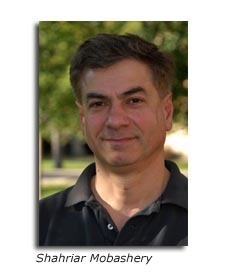
A team led by Prof. Shahriar Mobashery, the Navari Family Chair in Life Sciences, has documented how bacteria recycle their cell wall in the process of doubling, a critical step in understanding bacteria physiology. The team, using synthetic cell wall pieces and synthetic products of fragmentation, characterized an unusual chemical reaction that is a key to the process. A paper about the research, “Lytic Transglycosylase MltB of Escherichia coli and Its Role in Recycling of Peptidoglycan Strands of Bacterial Cell Wall,” will be published in the Journal of the American Chemical Society within the upcoming weeks.
“The cell wall is critical to bacterial survival, and it is a target for antibiotics,” Mobashery says. “Bacteria recycle their cell walls in each cycle of growth. This paper describes the process. This is one of those fundamental observations about the physiology of disease-causing organisms.”
Bacteria double—growing and splitting—about every 30 minutes. The material in the daughter cell is all new, but up to 60 percent of the parental cell wall has been recycled by degrading the material into fragments and rebuilding them. The MltB enzyme and other lytic transglycosylases initiate this process with an unusual chemical reaction. Part of the product of that reaction diffuses as an inflammatory agent, contributing to the pathology of infection. Another part is entrapped by a membrane-bound transporter protein and recycled in the cell wall.
Mobashery’s team prepared cell wall components, introduced MltB and observed the chemical reaction. They were able to characterize the product of the reaction. They also measured the rate of the transformation by MltB at 14,000 times per bacteria doubling time per molecule of MltB. The discovery provides understanding of the bacteria cell wall that could aid in fighting disease. “Opportunities are going to come when you fully understand how the organism ticks,” Mobashery says. The work was sponsored by the National Institutes of Health. The Mobashery team responsible for this discovery includes Maxim Suvorov, Mijoon Lee, Dusan Hesek and Bill Boggess.